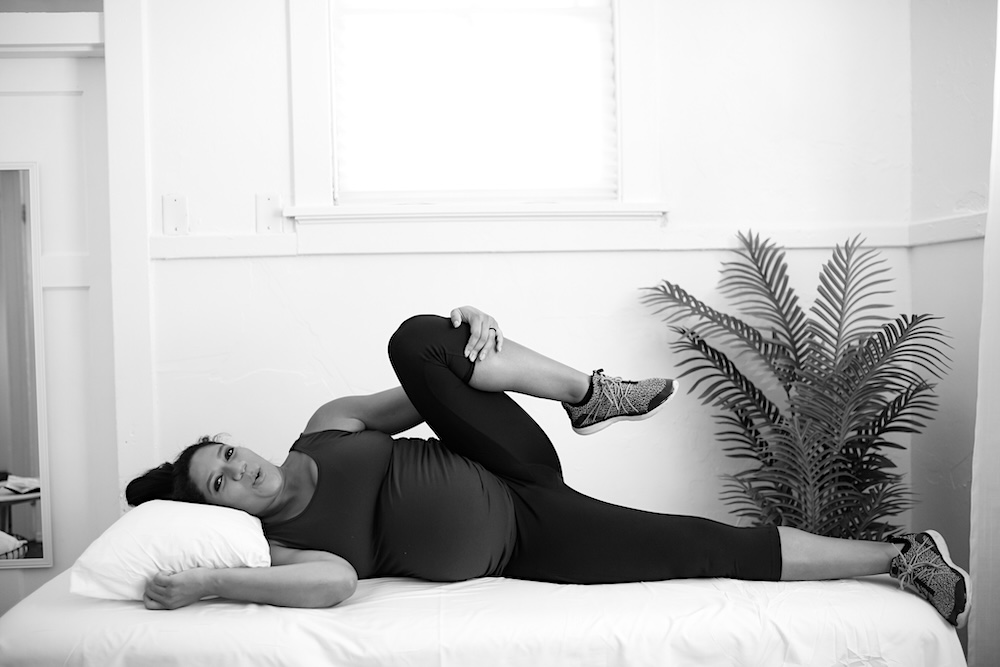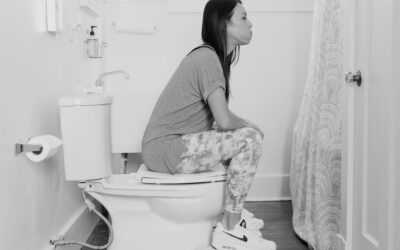Pregnancy is tough on your pelvic floor and core.
You may pee a little when you laugh, cough, or sneeze.
You may get *really* constipated.
You may find yourself waddling to the bathroom.
And hemorrhoids? Wild.
We’re often told to expect pelvic floor problems during pregnancy. But here’s the truth: While pelvic floor problems are common, they’re not normal.
One of the best ways to prevent pregnancy and postpartum pelvic floor problems is to exercise during pregnancy. (Yes, really!)
So let’s talk about what core exercises are safe during pregnancy.
Core Exercises in Pregnancy 101
Q: Are core exercises safe during pregnancy?
A: Probably!
It’s a myth that all core exercises are unhealthy or unsafe in pregnancy. For most pregnant folks, core workouts are actually necessary to boost your and baby’s health throughout the pregnancy.
Always do a medical review with your provider before returning to or starting a workout routine.
But, if your pregnancy is low-risk, they’ll likely say something like: If you were regularly working out before pregnancy, there’s a good chance you can continue your regular workout routine (for now). Just remember, pregnancy probably isn’t the time to set a new personal record for running or weightlifting. Modifications are needed as pregnancy progresses.
If you’re new to the workout game, start slow and low-impact. Walking and pregnancy-specific core exercises are an excellent way to stay healthy throughout your pregnancy. Again, no PRs. Just safe and healthy movement!
Q: What are the benefits of core exercise in pregnancy?
A: There are a lot of them.
Throughout pregnancy, your pelvic floor and core change dramatically. Then, they work together to safely labor and deliver your baby. They then change again in postpartum and continue to be an important health indicator through the lifespan.
Your pelvic floor is the group of muscles attached to your pelvis that controls everything mentioned above and then some! Its job is to support your bladder, rectum, and reproductive organs. This means your pelvic floor is the #1 culprit for all issues with peeing, pooping, sex, and childbirth.
And plenty of pelvic floor problems–particularly in pregnancy–can be better managed with safe and intentional movement:
- Feel backed up? Exercise.
- Have hemorrhoids? Exercise.
- Experience round ligament pain? Exercise.
- Dealing with back discomfort? Exercise.
Your abdominal muscles also play a big part. They have to be strong and coordinated to work with your pelvic floor as your whole body changes to accommodate your growing baby.
When done correctly, pelvic floor and core exercises in pregnancy are essential to strengthening and coordinating your core and pelvic floor, stabilizing your expanding pelvis, decreasing overall pain, and performing everyday activities with greater ease.
Core and pelvic floor exercises in pregnancy can also help you prepare for Delivery Day. Whether you deliver vaginally or via C-section, you can prepare your down there for childbirth!
Exercise in pregnancy is really good for your baby’s health, too. Research shows both pregnancy- and birth-related benefits and long-term positive health implications for your new little one.
Q: Are planks and crunches safe during pregnancy?
A: It depends on your point in pregnancy.
Throughout your first trimester, most core exercises are safe. But, as your uterus grows, you’ll want to avoid exercises that increase intra-abdominal pressure.
Crunches or sit-ups are two exercises to skip or modify, especially after the first trimester. That’s because they require you to lie on your back and increase intra-abdominal pressure as you engage your core to crunch.
Planks and other static, endurance-based exercises are actually safer than crunches! They’re also really helpful at strengthening your abs and back while putting less pressure on your spine. As you get into your second and third trimesters, try modified planks instead—on your knees or with your hands on a sturdy countertop.
With modifications–like belly breathing or side-facing exercises–you can mitigate intra-abdominal pressure and continue to safely work your pelvic floor and core through each stage of pregnancy.
Q: Are there any core exercises to avoid during pregnancy?
A: Modification is key.
There’s only one big exercise no-no: Don’t lie on your back after 20 weeks for a prolonged period of time to avoid compression of the inferior vena cava, which supplies blood to your heart.
But it’s important to keep in mind that the goal of exercising your core during pregnancy is to maintain (not build) a strong core without putting additional stress on your pelvic floor and core.
That means modifying the following exercises because they put too much stress on your changing pelvic floor and core:
- Spinal flexion, like crunches
- Loaded lateral flexion, like sideways bending while holding weights
- Spinal extension, like arching backwards
- Twisting, separating your hip and shoulder movements
Generally, with modifications to avoid these specific movements, safe ab exercises during pregnancy are and highly beneficial!
Q: How does exercise change throughout pregnancy?
A: A lot!
As your pregnancy continues, you’ll need to modify your pelvic floor and ab workouts to accommodate your new center of gravity and pelvic alignment.
Try these tips to keep you safely working out throughout your 40+ weeks:
- Decrease workout intensity
- Use smooth, even surfaces
- Wear supportive garments like proper footwear and compression leggings
- Pay attention to core stability and balance
- Exhale on the way down and up in any workout
- Avoid exercises requiring lying on your back after 20 weeks
During your first and second trimesters, it’s most important to maintain core strength. Targeting your transverse abdominis muscles (your abdominal walls) instead of your rectus abdominis (your six-pack ab core muscles) will make the most of your movement.
In the third trimester, relaxation and coordination are most important. Keeping your core strong and your pelvic floor relaxed is essential for labor, delivery, and postpartum regardless of how you give birth.
Q: Where should I start?
A: Depends on your needs.
Again, strengthening is most important in the first and second trimesters. Relaxation is necessary in the third trimester to prepare for labor and delivery.
For strengthening, I like the transverse abdominis (TA) contractions.
- Lie flat on your back with your left leg and right leg bent, feet resting on the floor.
- Perform a diaphragmatic breath inhalation to prepare.
- Exhale, then perform a Kegel as you draw your pelvic floor and lower abdominals inward.
- Imagine gently drawing your hip bones together to engage your deep core.
- Inhale, return to the starting position, and repeat.
For relaxing, cat-cow is a crowd favorite.
- Get on all fours.
- Begin in a neutral position with your hands shoulder-width apart and your knees bent directly below your hips.
- Inhale deeply and curve your lower back, bringing your head up and tilting your pelvis.
- Exhale deeply and bring your abdomen in, arching your spine and bringing your head and pelvis down.
- Repeat the stretch.
Q: When should I slow down or stop exercising during pregnancy?
A: Listen to your body.
Exercise should never hurt. If your current workout routine causes any pain, stop and follow up with your provider before trying again. Urinary and fecal leakage or urgency is another warning sign to slow or stop your core exercises.
You should also stop if you notice symptoms of urinary leakage, pressure or heaviness in your vagina, or diastasis recti. Diastasis recti is abdominal separation that often shows up in later pregnancy, and it’s important to periodically check yourself after your first trimester.
The most common signs of diastasis recti:
- Inability to activate your abs or feeling extremely weak.
- Pulling or stretching sensations in the middle of your abs with high-level core exercises.
- Doming or coning when lifting, exercising, or bowel movements.
Safe Core Exercises During Pregnancy: Try These!
Now that you know how to exercise safely during pregnancy (and why), try one of these workouts based on how far along you are.
First Trimester
Second Trimester
Third Trimester
Get More Pregnancy-Safe Pelvic Floor and Core Workouts
Continuing or adding a workout routine to your pregnancy to-do list might seem daunting. But you don’t have to do it alone thanks to The V-Hive Membership. Check out these two programs to get you started:
- The Pregnancy Program (weeks 4-33 of pregnancy): A week-by-week suite of pelvic floor and core workouts designed especially for pregnant bodies, with pelvic tilts, leg lifts, bird dogs, and more!
- The Childbirth Preparation Program (weeks 34-40 of pregnancy): Prepare your pelvic floor and core for a confident childbirth experience.
Then, explore 6 more complete programs to support you in postpartum and beyond. You can get it all here for one low monthly fee. (But your first week is F-R-E-E!)





